| |
|
| |
|
|
|
|
|
|
| |
 |
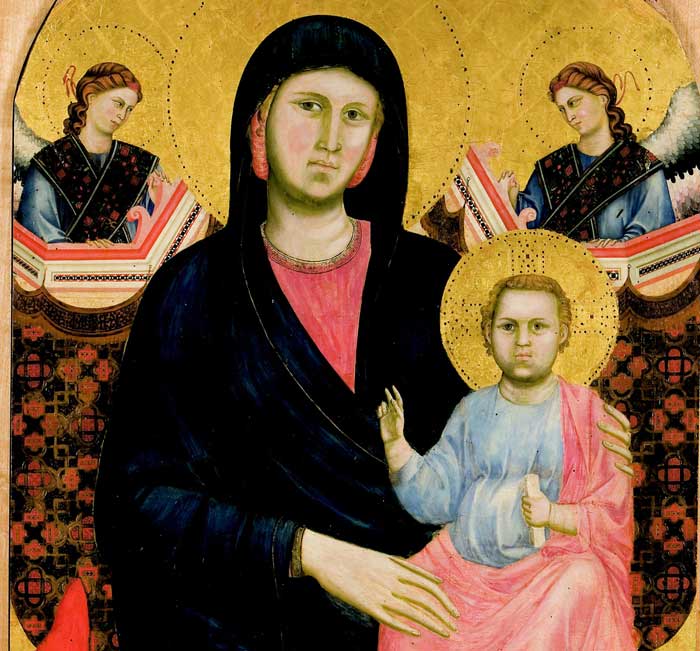 |
| |
Giotto, Madonna and Child, 1295-1300, tempera on wood, 180 x 90 cm, San Giorgio alla Costa, Florence [ 1]
|
|
 |
|
| |
|
|
|
| |
|
Giotto, Madonna of San Giorgio alla Costa
|
|
|
|
| |
|
| After the decoration of the Upper Basilica of Assisi, Giotto is thought to have painted the Madonna and Child Enthroned in the church of San Giorgio alIa Costa in Florence.
The painting takes the name of the church in which is had been conserved until a few decades ago. The Madonna of San Giorgio alla Costa was attributed to Giotto only in 1939 by German art critic Robert Oertel [2]. For many years, it was left in the deposits of the Santo Stefano al Ponte church, where is was damaged on May 27, 1993 in a mafia bombing that claimed the lives of five people. It was restored by experts at the Opificio delle Pietre Dure in Florence. During its restoration, the painting was cleaned and parts mended with chromatic solutions. Experts purposefully left a tear (in the left corner) in the canvas, caused during the bombing, as testimony to the horrible event that shook Florence. The shape of the painting today is not like the original: the painting has been cut on both sides and the lower part during the Baroque transformation of the church at the end of the 17th century. The triangular cusps were cut off, as were the sides of the painting.
At the end of the thirteenth and during the first years of the fourteenth century, a debate was going on in religious and theological circles between those who emphasized Christ's humanity, favored images of his suffering and death, and those — especially the Dominicans — who wanted to return to the more ancient theological tradition that emphasized the divinity of Christ and thus favored images of glory. For the latter group, death and the cross signify not only the moment of suffering, but the concept of resurrection. Giotto's panel, not by chance executed for a Dominican convent, is connected with this new theological and spiritual movement, and reveals a seldom noticed aspect of Giotto's personality. Even in his first works, and then throughout his long and finely articulated artistic career, he was an attentive and sensitive interpreter of the most gripping theological and spiritual problems of his day [3].
|
|
|
|
| |
|
In the painting, the Virgin Mary is sitting on a marble throne. The painting has a three-dimensional feel. Here, Giotto distances himself from the Byzantine style of painting which characterized art in those years. Indeed, the Virgin Mary is wearing the traditional red cap, but a few locks of hair are falling onto her shoulders. The gold engraved decorations are of particular relevance: some say this aspect was inspired by a mix of both Arabic writings and the French gothic style. Giotto’s early style is evident in this work, and can be linked to his frescos in Assisi, the Crucifix in Santa Maria Novella and the fragment in Borgo San Lorenzo. The date of its execution, therefore, cannot be far from the date of the frescos in Assisi. Many believe it was completed in the late-1200s.
'The cuspidated or toothed panel has been mutilated: it was cut on all four sides in the eighteenth century, so that it could be inserted in a baroque altar. Ghiberti was the first to mention a painting by Giotto in the church of San Giorgio: he was followed by other Renaissance historians and scholars.
It is now almost unanimously accepted as his work and placed chronologically alongside the Franciscan frescoes of Assisi. The Madonna sits on a Cosmatesque throne covered with a very rich cloth that allows us a glimpse of the traditional red cushion: her monumental posture is barely ruffled by a slight tilt of the head and the bend of knee pushing forward. She is clothed in the traditional colors — the red dress and the (now(blackened ) blue mantle — but she also wears a marforium (tight cap) that is bright red, a color not usual in the tradition. And the blessing Child, seated tile the mother in a rigid pose and wearing a costume of white tending to gray, is also covered by a red mantle'. Red also brightens the stoles of the beautiful angels behind the throne, as it does the ribbons in their hair. The vivid red prevails over the blue in this very lively, if not very rich, panel. Related to the better known and more famous Madonnas in Glory by Duccio and Cimabue, this panel exhibits the transition to a new figurative culture: the Madonna's figure now has "natural" proportions and her pose too is natural, while her face, shaped in accordance with classical canons (already seen in the figures on the higher tiers of the Assisi walls) has a unique, vivid expression. Her body is set off by deep drapery and is constructed by a precise chiaroscuro, though her sleeve and the costume of the child still show those sharp folds that one finds in the Assisi frescoes of the upper tier, and in the panels of the Santa Maria Novella Crucifix. Still, the panel is very refined in the use of Gothic cloth, and in the presence of the graceful little angels who look out from behind the throne. Again like the Crucifix, the panel exhibits a new style, confirming Giotto's new and powerful personality, surpassing the earlier and contemporary tradition, with his revolutionary ideas.' [3].
|
|
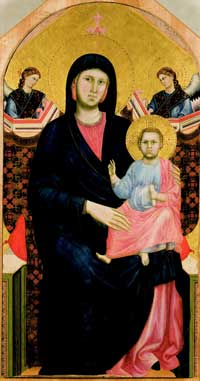
Giotto, Madonna and Child, 1295-1300, tempera on wood, 180 x 90 cm, San Giorgio alla Costa, Firenze |
|
|
| |
|

[1] Giotto (di Bondone) was the first of the great Italian painters, active in Florence. He decorated chapels and churches in Assisi, Rome, Padua, Florence, and Naples with frescoes and panel paintings. Because little of his life and few of his works are documented, attributions and a stylistic chronology of his paintings remain problematic and often highly speculative. His works in Rome include the heavily restored mosaic of Christ Walking on the Water over the entrance to St. Peter's Basilica, and an altarpiece from St. Peter's, now in the Vatican Museum. In Padua, his fresco of the Last Judgment decorates the western wall of the Arena Chapel, and the rest of the chapel is covered with his narrative frescoes featuring scenes from the lives of the Virgin Mary and Christ. Later in his career he executed frescoes in four chapels in the church of Santa Croce in Florence, two of which survive. In 1334 he was appointed surveyor of Florence Cathedral; his design for the campanile was altered after his death. The most important extant panel painting attributed to him is The Madonna in Glory (c. 1305 – 10). He achieved great fame in his lifetime, and he is considered the father of European painting for breaking with the impersonal stylizations of Byzantine art and introducing new ideals of naturalism and humanity, three-dimensional space, and three-dimensional form. The course of Italian painting was dominated by his students and followers. His work points to the innovations of the Renaissance style that developed a century later.
[2] Robert Oertel was a renowned authority on Giotto and the early Italian Renaissance. He published an habilitationschrift in 1948 on Giotto's post-Paduan style, qualifying him to teach in the university. He became a dozent in 1949, married in 1950, and appointed professor in 1955. Oertel was placed in charge of conservation for the Alte Pinakothek in Munich, part of the Bavarian state museums structure in 1958. After the death of Ordenberg Bock von Wölfingen (q.v.) in 1960, Oertel completed and published that scholar's manuscript on Giotto. He was named chief conservator in 1964. That year he was named Director of the Berlin Gemäldegalerie (Painting Gallery), where he served for the last eight years of his career.
[3] Francesca Flores D'Arcais, Giotto, Abbeville Press, (October 1, 1995), New York, London, Paris, pp. 105-107.
|

Museo diocesano di Santo Stefano al Ponte
Santo Stefano al Ponte is a church in Florence. The church was originally constructed in the 11th and 12th century in a Romanesque style with a polychrome marble facade. The interior featured three aisles. In the 14th century, the exterior was renovated. Of the original facade, only the marble work around the portal remains. Between 1631 and 1655, the interior of the church was renovated to convert the three aisles to an open hall. A crypt was added and the interior was redesigned to include a choir.
Owing the latter part of its name to its proximity to the Ponte Vecchio, Chiesa di Santo Stefano al Ponte was first mentioned in recorded history in 1116 although its Romanesque architecture suggest it is actually much older. A mixture of features such as its Roman façade, Medieval entryway, and altars that date to Renaissance times make visible its long and varied history. Now deconsecrated, the church is home to the Orchestra Regionale Toscana and offers a stunningly authentic acoustic and cultural setting to experience some of Italy's best classical music.
The annexed Diocesan Museum houses a panel with a Madonna by Giotto and exhibits works of art taken from other churches in town and in the territory of the diocese of Florence, which can no longer be perserved in the original churches for safety reasons.
Marco Ciatti e Cecilia Frosinini (a cura di), La Madonna di San Giorgio alla Costa di Giotto. Studi e restauro. , Edifir, Firenze 1995.
Alvaro Spagnesi, Sergio Pacciani, Santo Stefano al Ponte Vecchio, Edizioni della Meridiana, Firenze 1999.
Francesca Flores D'Arcais, Giotto, Abbeville Press, (October 1, 1995), New York, London, Paris.
|
|
This article incorporates material from the Wikipedia article Giotto di Bondone published under the GNU Free Documentation License.
Wikimedia Commons has media related to Giotto di Bondone and Museo diocesano di Santo Stefano al Ponte |
| |
|
|

|
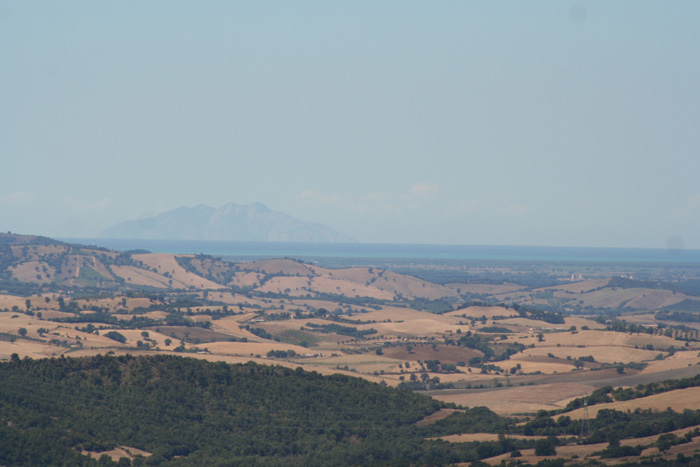 |
¨Podere Santa Pia offers its guests a breathtaking view over the Maremma hills and is the ideal location for those who wish to enjoy total privacy.
|

Holiday accomodation in Tuscany | Podere Santa Pia | Artist and writer's residency
|
| |
|
|
|
|

. |
|
|
Podere Santa Pia |
|
Podere Santa Pia, garden view, April |
|
View from Podere Santa Pia
on the coast and Corsica |
 |
|
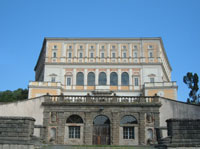 |
|
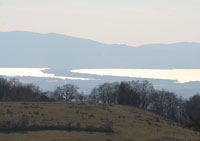 |
| The towers of San Gimignano |
|
Farnese |
|
Monte Argentario |
| |
|
|
|
|
|
|
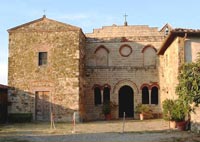 |
|
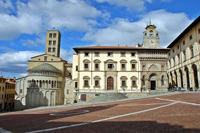 |
Montalcino |
|
Chianti region |
|
Arezzo |
| |
|
|
|
|
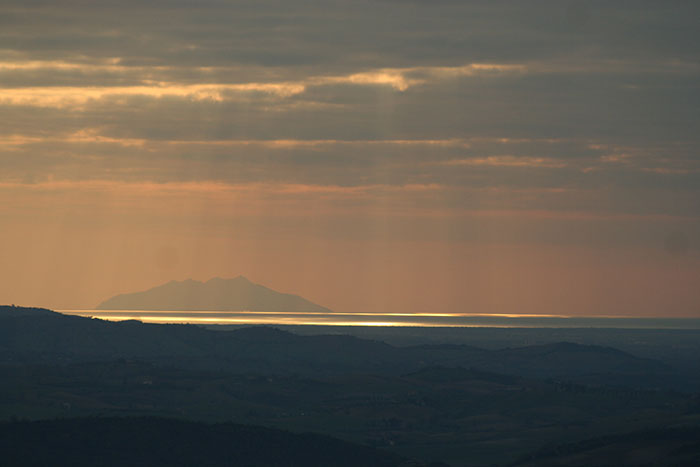 |
Monte Christo. Situated in panoramic position, overlooking vineyards and olive trees, Santa Pia features incredible sunsets...
|
Museo diocesano di Santo Stefano al Ponte
The museum was openend only in 1996 after long restoration works that were necessary to rebuilt the rooms after the explosion of via dei Georgofili in 1993. The works of art had already been collected and made accessible only to scholars for over ten years in the diocesan warehouse. The restoration plan, which was possible thanks to the contribution of the Regional Administration of Tuscany, has implied building the necessary systems and adding value, thanks to a new layout, not only to the exhibited works, but also to the church, dedicated to Santo Stefano and Santa Cecilia.
This building already existed in 1116, although its Romanesque facade had been built in different stages starting from the lower section (1233). The interior of the church, restructured in the 17th century by the architect Ferdinando Tacca still preserves a magnificent and elegant Manneristic staircase, which is even earlier that the prepytery, designed by Bernardo Buontalenti (1574) and transferred from the church of Santa Trinita. The museum is arranged on three different levels and gives access to a small cloister with a Renaissance well, where the cells of the monks opened. This was the seat of the Agostinias from the congregation of Lecceto from the 16th to the 18th centuries. The exhibition highlights some extraordinary masterpieces of Italian art like the "Madonna" by Giotto that was originally located in the church of San Giorgio alla Costa, The "Adoration of the Magi" by Paolo Uccello and "St. Julian" by Masolino; besides displaying a well-assorted and precious series of liturgical objects and vestments, which includes also a very expressive polychrome plastic |
|
|
| |
|
|
|
| |
|
|
|
| |
|
|
|
| |
|
|
|
| |
|
|
|
| |
|
|
|













